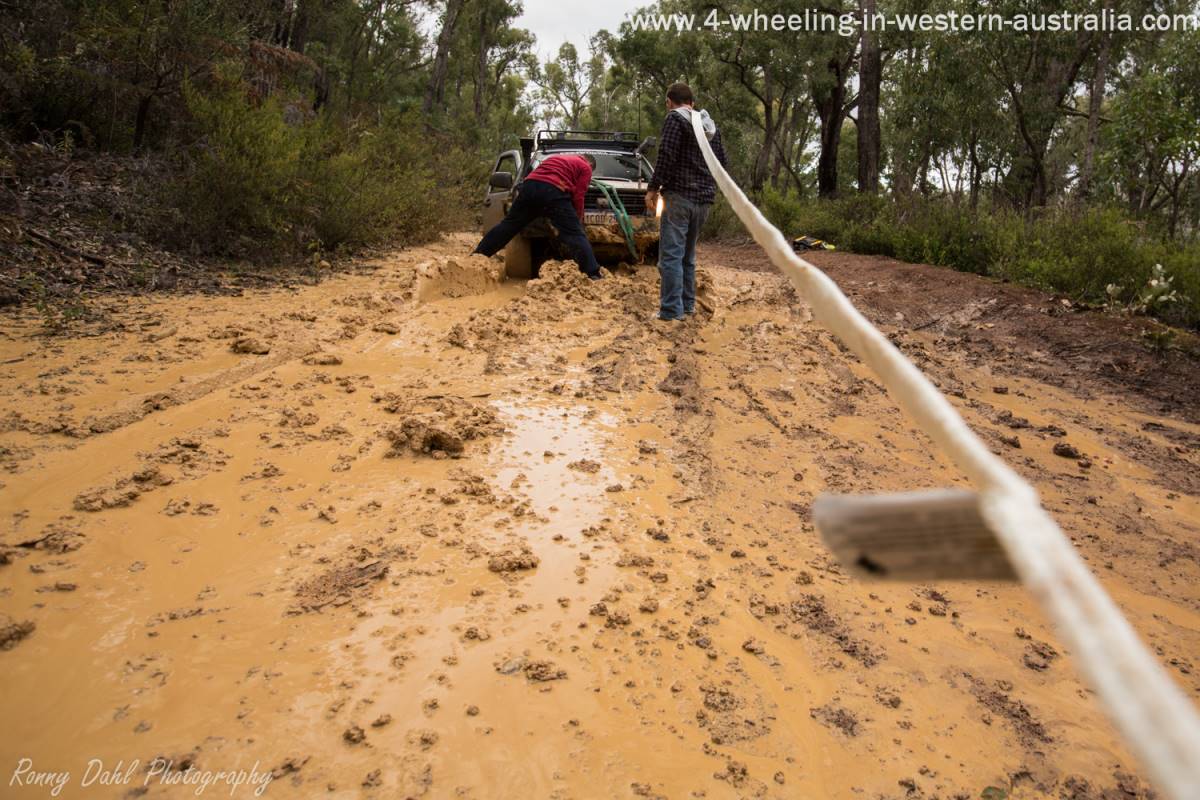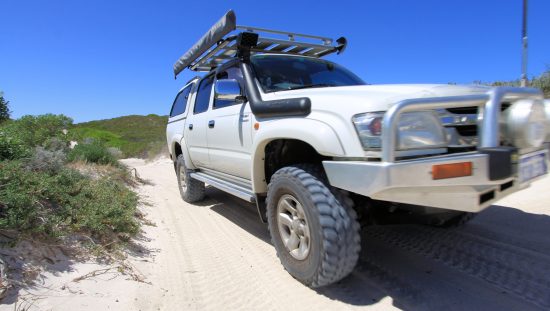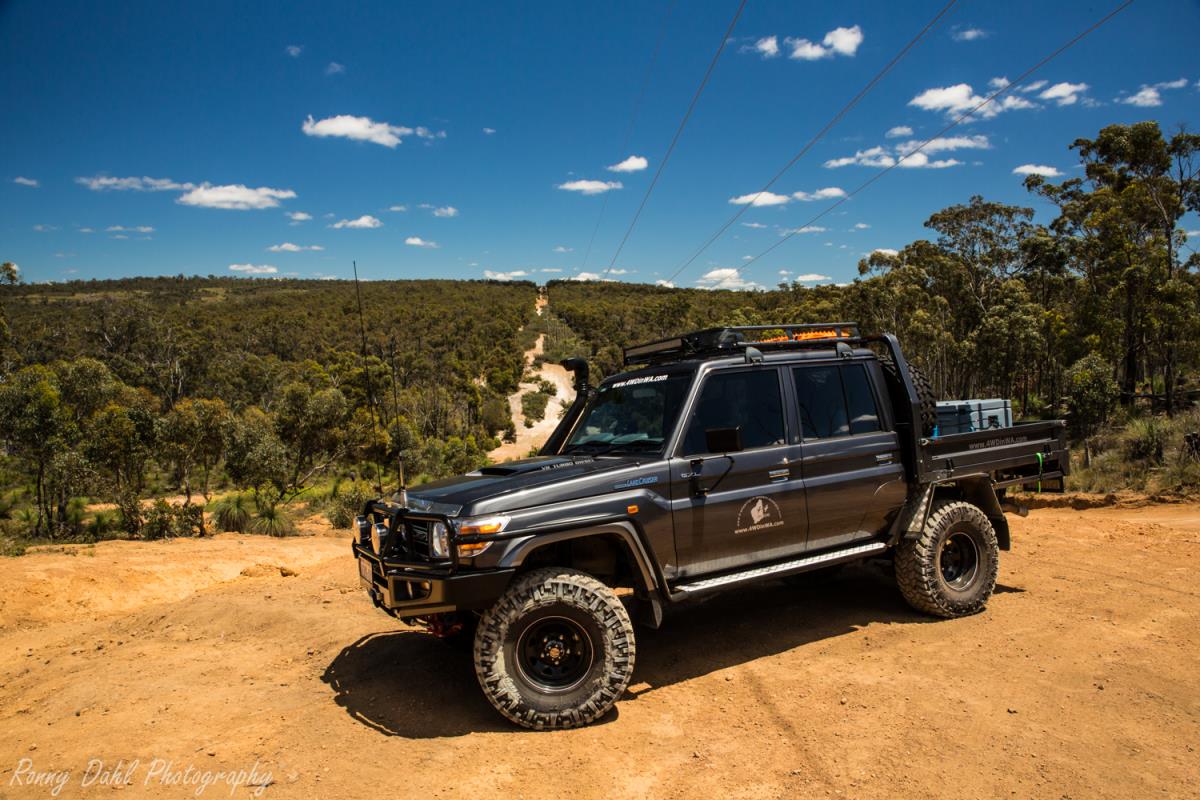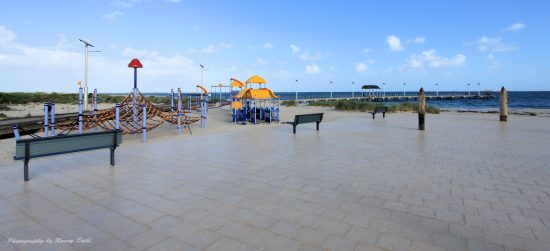
Snatch Strap Recovery.
Using a Snatch Strap for snatching a vehicle out is one of the fastest ways to recover a vehicle, because of the speed and sudden forces involved there is less control on the recovery if something goes wrong.
Both 4WD,s must be fitted with rated recovery points in order to use the strap safely.
How The Recovery Works:
Kinetic energy! Like a strong rubber band once at maximum stretch it will retract (or break if worn or pushed past its load limit).
The recovery vehicle will usually have the strap attached to the rear on a rated recovery tow hitch (NOT THE TOW BALL). The bogged 4x4 will be attached with the other end of the strap, lest assume the bogged 4x4 is being pulled forward meaning the strap will be attached to a front recovery point.
The recovery vehicle will now reverse back towards the bogged 4x4 as close to
within 5 meters, when both parties are ready (being ready means the bogged 4x4
is out of gear or in gear with wheels slowly turning and the hand brake is
off!) using the CB radio or car horn signals previously
agreed on.
The recovery vehicle can now start snatching the bogged 4wd out.

Getting ready to snatch.
Ten steps to general snatch strap recoveries (some situations require a different
method,
however this "general" method will do for most snatch
recoveries)
Step 1: Asses how stuck the bogged 4WD is
Step 2: Clear any sand, rocks or whatever is in front of the bogged vehicle
(that can be moved) to assist in recovering and reducing stress to the snatch
strap
Step 3: Recovery vehicle to move into position (depending on how stuck the
bogged 4WD is the run up and speed will vary)
Step 4: Attach the snatch strap to RATED recovery
points to both 4 wheel drives
Step 5: Both drivers need to agree on signals (with car horns) or use the CB
radios if available.
Step 6: Have someone keeping an eye on the recovery from outside the vehicles,
this way someone can to stop the recovery if something's not quite right.
Step 7: The bogged 4x4 needs to prepare and make sure the hand brake is off
Step 8: Make sure no one is within the radius of the snatch strap length (if
snatch is 9m long keep a ten meter minimum distance from both vehicles and
stand behind something when possible)
Step 9: Now that everyone is ready the bogged vehicle needs to let the recovery
vehicle know when to proceed, the bogged vehicle will now start to spin the
wheels just before the recovery vehicle attempts to snatch the bogged 4WD out.
Step 10: If not out, check what's going on, double check no one has the hand
brake on and repeat steps 8 & 9 adjusting force, speed and run up until the
bogged 4x4 is out.
Note*
Experienced people with snatch strap
recoveries will have a general idea of how much force is required judging by
the situation they are in.
For beginners it is quite surprising how powerful a strap is, if a large
vehicle is snatching a small 4x4 a much less force/run up and speed is
required. The other way around is very different as you might have already have
guessed, small vehicle recovering a large vehicle (small Suzuki recovering a
large Nissan patrol) will require a good run up with some speed.

Snatching the 4x4 out of the mud.
What if we only have the tow ball and no other
recovery points?
DO NOT USE THE TOW BALL, people have died from doing this!!!
What can be done if you absolutely have no other choice is to use a tree trunk protector and wrap it around the rear bar (the factory rear bar which is part of the chassis) which the tow hitch is attached to.
Very easy to do on tray backs and can only really work if pulling directly back.
Pulling from and angle could
damage the bogged vehicle as the wrapped tree trunk protector may slide
suddenly!
Other general safety tips:
Never
try to detach a strap under tension.
Never step over a snatch strap under tension and never go near one.
If walking across a strap attached to a vehicle (which is not under
tension), step on the actual strap. You'd rather get thrown than getting groin
alterations if someone all the sudden decides to begin the recovery while you
are crossing the straps.
Only use the minimal amount of shackles and attachments required, if something
was to go wrong there are less metal objects flying about.
Check the straps
before and after using them, snatch straps can have a very long life if used
right. However if any sign of wear cut it up and throw it
out.
The straps store energy and should only be used 3 times in a row as they weaken and will be easy to break, a 24 hour rest will bring the snatch-strap back to optimal strength.
Use a blanket, jacket or winch damper over the strap before under
tension. This will force the strap to the ground if it breaks and will help to
slow any flying metal objects "if" something was to go wrong or give
way.
Maintaining the recovery gear:
Mud and UV sun light damages straps. Wash after mud recoveries and don't dry
them in the sun light.
When using D shackles tighten them all the way and then loosen back by half a
turn. This prevents the shackle from seizing up/shut while under the heavy
forces.
Recovery kit:
General kit should have the following:
1 snatch-strap, 2 D shackles and a winch damper (towel, jacket or blanket)
Advanced kit:
2 snatch straps, 3 D shackles, extension strap and winch damper (towel, jacket
or blanket.
Only combine snatch straps and extension straps if your experienced.
4WD RECOVERY MINI SERIES:
See our 4WD recovery videos showing you how to use recovery gear in the correct and safe way.
These video are part of our mini series currently being filmed and expanded so subscribe on YouTube or check back here at this link for new content.
Recent Articles
-
Goodyear wrangler MTR
Jun 28, 24 10:27 PM
I have these on my defender 90 and my Dmax Ute. I get around 100,000 km out of them. I tried AT for one change and went back to the MTs. They are gol -
4x4 off road tracks 0 to 250 km from Perth
Nov 21, 23 07:40 PM
On this page we cover 4x4 off road tracks within a 250 km radius from Perth... -
4 Wheeling Around Jurien Bay.
Nov 21, 23 07:35 PM
Jurien Bay 4x4 tracks info and general information about the area...
- Home
- 4x4 Recovery
- Snatch Strap
Leave Snatch Strap And Go 4 Wheeling In Western Australia.





